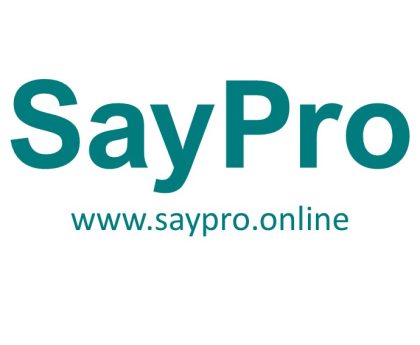SayPro Stock Tracking & Monitoring Monitor the movement of goods and ensure inventory is maintained at optimal levels FROM SayPro Monthly March SCMR-17 SayPro Monthly Inventory Management: Stock tracking, order fulfilment, and supplier management by SayPro Online Marketplace Office under SayPro Marketing Royalty SCMR
1. Overview
The SayPro Stock Tracking & Monitoring system forms a critical component of SayPro’s logistics and inventory infrastructure. As presented in the SCMR-17 March Report, this subsystem is tasked with the end-to-end monitoring of goods movement across SayPro’s online marketplace and associated warehouses, while simultaneously maintaining inventory levels at predefined optimal thresholds to support seamless operations and customer satisfaction.
2. Objectives
- Track the movement of goods from suppliers to warehouses and from warehouses to customers.
- Prevent overstocking and understocking by maintaining inventory at optimal levels.
- Ensure the efficiency, traceability, and accuracy of every stock transaction.
- Improve the responsiveness of the supply chain to changing demand patterns.
3. Movement of Goods: Monitoring and Control
3.1 Inbound Movement (Supplier to Warehouse)
- Goods delivered from suppliers are logged into the system through digital receiving forms with barcode/RFID scans.
- Each delivery is matched against purchase orders and expected delivery schedules.
- The system flags any discrepancies (e.g., shortages, delays, damaged goods) for supplier follow-up and claims processing.
3.2 Internal Movement (Warehouse Transfers)
- Inventory transfers between regional warehouses are tracked through internal stock transfer logs.
- Real-time updates ensure receiving locations have visibility on incoming stock.
- Movement histories are stored in the central inventory management database with GPS tags and timestamps where applicable.
3.3 Outbound Movement (Warehouse to Customer)
- Upon order fulfillment, goods are picked, packed, and dispatched under the guidance of automated pick-lists.
- The inventory system deducts items immediately after order dispatch to ensure up-to-date availability.
- All outbound shipments are integrated with SayPro’s order tracking system to monitor delivery completion.
4. Inventory Optimization Strategy
4.1 Optimal Stock Level Calculation
- The system calculates optimal stock levels based on:
- Historical sales data
- Seasonal trends
- Product lead times
- Safety stock policies (buffer stock for emergencies)
4.2 Demand Forecasting Integration
- SayPro uses predictive analytics to forecast demand, allowing stock levels to be adjusted proactively.
- Stock alerts and auto-replenishment requests are generated when projected demand exceeds current availability.
4.3 Dynamic Reordering System
- Each product is assigned a Reorder Point (ROP) and Economic Order Quantity (EOQ).
- When inventory falls below the ROP, the system triggers:
- An automatic reorder alert to suppliers
- A suggested restocking quantity based on EOQ and lead time
4.4 Overstock Management
- Excess inventory is flagged and reported in monthly SCMR metrics.
- Overstock strategies include:
- Flash sales
- Bundling with fast-moving products
- Supplier return negotiations
5. Real-Time Dashboards and Alerts
- Inventory Movement Dashboard:
- Displays real-time stock-in and stock-out activities.
- Color-coded indicators for urgent actions (e.g., critical low stock).
- Alerts and Notifications:
- Email and SMS alerts for supply chain managers on:
- Inventory level breaches
- Shipment delays
- Inventory anomalies (e.g., sudden drops)
- Email and SMS alerts for supply chain managers on:
- Reporting Suite:
- SCMR-17-based monthly reports include:
- Inventory Turnover Ratio
- Average Days Inventory Outstanding
- Supplier On-Time Delivery Rate
- Stock Variance Reports
- SCMR-17-based monthly reports include:
6. System Integration and Data Flow
- Modules Linked:
- Inventory Management
- Order Fulfillment
- Supplier Management
- Customer Service
- Data Flow:
- Stock movement is captured at source (goods in/out).
- Updates are synced with central database.
- Changes reflect instantly in sales channels, dashboards, and supplier interfaces.
7. Compliance and Governance
- Governed under the SayPro Marketing Royalty (SCMR) operational policies.
- Adheres to monthly audit trails and performance reviews.
- Inventory KPIs are aligned with organizational SLAs and business continuity standards.
8. Key Benefits
- Enhanced visibility across the supply chain.
- Reduced inventory holding costs.
- Improved order accuracy and customer satisfaction.
- Faster response to supply disruptions or demand spikes.



